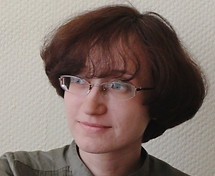
TAWRIN BAKER
University of Pennsylvania
Somewhat Diaphanous, Somewhat Thick”: Light, Color, Density, Rarity, and the Crystalline Humor in the Early Seventeenth Century
Theories of vision underwent radical changes in the seventeenth century. The basic contours of this shift are well known, but accounts of light, color, the eye, and perception were tightly interwoven, and scholars still have not unravelled this shift in detail. In particular, the connection of the above to the notion of density (or thickness) and rarity (or tenuity) has been under-appreciated, and pre-modern concepts of density and rarity are still poorly understood. This talk investigates the description of the crystalline humor in the first part of the seventeenth century in order to better understand changes in accounts of light, color, and perception. Since Ibn al-Haytham the crystalline humor had been described as somewhat diaphanous, in order to admit rays of light and color, but also somewhat dense or thick, in order to delay, retain, and “suffer” the impressions of these rays. This description of the crystalline humor was ubiquitous in the Perspectivist tradition, and over time this description was increasingly seen in works of anatomy and natural philosophy. The beginning of the seventeenth century saw the rise of corpuscular and mechanical philosophies, the development and acceptance of the retinal theory of vision, the growth of the science of mechanics, and practical and theoretical attention to the problem of glass lenses and refraction. The relationship between these developments and theories of light, color, and perception were complex, but by carefully analyzing accounts of the crystalline humor (and, later, the retina), the problem of how theories of light, color, and perception changed, and why, becomes more tractable.

KATERINA IERODIAKONOU
National and Kapodistrian
University of Athens
Byzantine Philosophers on Vision
Theories of vision seem to have drawn the attention of the Byzantines for different reasons depending on their different perspectives; theologians were interested in supporting their iconophile views by appealing to the superior sense of sight, medical doctors wanted to find out more about the anatomy of the eyes and their function as organs of vision, scholars were intrigued by the ancient philosophical doctrines on vision and its objects, namely colours, as well as by the optical theories elaborated by the ancient mathematicians. Theories of vision were thus placed in Byzantium, as in most other periods and civilizations, at the intersection of natural philosophy, mathematical optics and medicine. For the most part, however, it is in connection with Byzantine aesthetics, and in particular in connection with the Byzantine icons, that contemporary scholars have been investigating Byzantine theories of vision and of light. There are very few studies about the physiology of vision, or for that matter about the role of vision in the acquisition of human knowledge, despite the fact that there is plenty of material on these topics in our surviving Byzantine sources. My task , though, is much more limited. I merely focus on the writings about vision of some Byzantine authors from the 11th to the 14th century, who have been categorised as theologians, philosophers, astronomers, or medical doctors, and who composed commentaries on the relevant Aristotelian treatises, introductory textbooks or small essays on natural philosophy and, more specifically, on vision.

Chasing the Light: What Happened to the Ancient Theories?
In the course of contemporary investigations into the history of optics, it is claimed that the study of light in antiquity was subordinated to the study of sight. Previous scholarship allowed some conceptual space for an autonomous study of light. But such an approach remains elusive. In this paper, I want to explore further the possibility of a luminocentric as opposed to the oculocentric approach to ancient optics. Based on evidence from the Platonic Timaeus, I argue for the existence of proper theories of light in the ancient world. If my argument is correct, these theories ought to be part of a comprehensive and systematic history of optics.
ISIDOROS KATSOS
Pembroke College, Cambridge University

New Light on Transmission Studies: Optics in Arabic and Persian (ca. 1020s-1520s)
This presentation is focused on a few optical texts in Arabic and Persian during a 500- years period, in order to throw new light on pressing problems in transmission. The texts range from the Optics of Ibn al-Haytham (composed ca. 1020s-1030s) and its commentary by Kamal al-Din Farisi (composed. ca. 1304) both in Arabic, to an anonymous optical text known in both Arabic and Persian (composed ca.1512-1520), with its own revelations about transmissions, especially those with reference to Europe. Highlights include unknown and understudied passages concerning theories of ‘indirect vision’ involving light reflection and refraction, discussed in the context of transmission, as well as non-transmission, of optical works.
ELAHEH KHEIRANDISH
Harvard University

SVETLANA MESIATS
Russian Academy of Sciences
Moscow
Is it Possible to See Darkness? Goethe and Aristotle on the Role of Light in Vision
The great German poet and writer Johann Wolfgang Goethe (1749 – 1832) is also known as an outstanding scientist and the author of an original theory of color that appears to be remarkably different from that of Isaac Newton. According to Goethe, all physical colors can be deduced from a simple primordial phenomenon (so called “ur-phenomenon”) that takes place every time as light or darkness acts through a semi-transparent colorless medium either on our eyes or on opposite surfaces. This “general rule of all color phenomena” was severely criticized by some of Goethe contemporaries. They were puzzled by the active role of darkness in his color theory and argued that it is impossible to see darkness through an illuminated medium because of its being no more than a privation of light. Yet this argument makes sense only within the framework of the Newtonian notion of light as the principal agent in a production of all color sensations. Goethe however held a more traditional view on the nature of light and color, the origin of which can be traced back to Aristotle. According to Aristotle, colors cannot be derived from the light, they are qualities of external objects that light merely makes visible. Color requires light because it requires a medium. For vision to take place the colored object must first affect the actually transparent, which in its turn affects the faculty of sight. In my presentation I’m going to answer the question what is the role of the transparent medium in vision? But what kind of change does color produce in the light? This question provokes a lot of debate both among the ancient and modern interpreters of Aristotle. On the one hand, Aristotle says that the transparent is capable of receiving colors, which probably means that it becomes colored. On the other hand, if the medium itself had a colour, then we would be unable to see anything through it because of its no longer being transparent. In my view, the solution can be found in Alexander of Aphrodisias’ distinction of two modes of getting colored: “affective” (παθητικῶς) and “relational” or “positional” (κατὰ σχέσιν). Positional mode of coloration implies that the color borrowed by a body remains alien to it and doesn’t change its previous hue. And as far as transparent bodies for the most part undergo “positional” coloration, they do not lose their transparency and continues to be colorless while reflecting a hue of an external object. Colored objects including the black ones effect in them some sort of shine or brilliance (αὐγή) which bears a hue of an object’s color. Therefore Aristotle’s theory of light can explain how the black color or darkness can be seen through the illuminated transparent medium.

LUKAS MUEHLETHALER
Freie Universität Berlin
Extramission as a Model for Apprehension in Abū l-Barakāt al-Baghdādī
The twelfth-century Jewish philosopher Abū l-Barakāt al-Baghdādī shows genuine interest in problems related to vision in his treatise "On the reason why the stars are visible at night and hidden in daytime". His most extensive discussion of theories of vision, however, appears in the physics and metaphysics of his Kitāb al-Muʿtabar fī l-ḥikma where extramission becomes – rather surprisingly – a model for one aspect of his innovative epistemology. The paper argues that although Abū l-Barakāt showed an understanding of contemporary theories of vision, his discussion of these theories was driven by philosophical conundrums related to his epistemology and that his use of the extramission model might not indicate his preference for a particular model of vision.

KELLI RUDOLPH
University of Kent
Colour and Light in Democritus' Theory of Vision
Democritus notoriously insists that like sweet and bitter and hot and cold, colours are “conventional” (DK68B9). These qualities arise from the rhythm or shape (rhusmos/schēma) contact or arrangement (diathigē/taxis) and turning or orientation (tropē/thesis) of the only real things, namely, atoms and void (DK67A6). Aristotle criticises Democritus and the majority of the natural scientists for making ‘all the objects of sense objects of touch’ (DK68A119), but for the atomists, at least, this is an advantage rather than a draw back. For Democritus, I argue, the role contact and orientation plays in colour vision is a component of its conventionality, ultimately making perception at a distance multi-sensory. I begin by examining Democritus’ account of bright and dark within the broader context of the atomist’s approach to vision in order to establish his basic explanatory framework for colour formation and colour vision based on distinctions between light and dark. I then turn to the discussion of red, green and the mixed colours to understand how and why Democritus departed from the exclusively bright-dark account of colour favoured by his contemporaries, and how his account seems to make use of technological advancements to account for these colours. Finally, I return to the vexed question of sensory conventionality, demonstrating how Democritus’ approach to colour helps us better understand the real-conventional distinction.

Rereading Ptolemy’s Optics: in Search for a Theory of Vision
If the first book of Ptolemy's Optics had been preserved, we would have the thorough presentation of his visual theory and plenty of reason to discuss it. Nevertheless, the talk aims to provide clues as to what we have lost and how complex this theory must have been. The hints and comments scattered throughout the text reveal some features and aspects of the visual process. These elements will hopefully be useful in order to carry out a new reconstruction based on textual evidence and to relate the Ptolemaic theory of vision to what we know from antiquity and later times.
HARALD SIEBERT
Technische Universität Berlin

All the Light We Cannot See: Theories of Vision in Johannes Kepler and ibn al-Haytham – A Comparison
In the fields of optics and catoptrics, the works of the German polymath Johannes Kepler (1571-1630) mark an important turning point. In his Ad Vitellionem paralipomena(1604), Kepler is the first who describes the retinal image in the eye correctly. However, this does not mean that we cannot trace back his paradigm-shifting ideas to theories earlier in history: One of the most influential authors, ibn al-Haytham (Alhazen), had a significant influence on many theorists who worked on optics, including Roger Bacon, Leonardo da Vinci, and Johannes Kepler. In the present paper, I will try to sketch both Alhazen's and Kepler's theories of vision, pursuing the question in what way Kepler's theory was coloured by the one of Alhazen.
SINEM DERYA KILIC
Humboldt-Universität zu Berlin